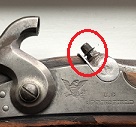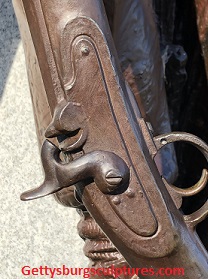Gettysburg Sculptures
I HAVE A NEW SITE NAMED "GETTYSBURG REMEmBERED" PLEASE SEE THIS SITE FOR CONTINUING INFORMATION ON THE GETTYSBURG BATTLEFIELD. I HOPE TO SEE YOU THERE.
CLICK THIS LINK TO VISIT GETTYSBURG REMEMBERED SITE
Gettysburg Sculptures
United States
- Gettysburg Sculptures Home

- About Us
- Contact Gettysburg Sculptures
- Northern Equestrian Monuments at Gettysburg
- Northern Officer's Statues at Gettysburg
- Bronze Southern State Memorials at Gettysburg
- Northern Regimental Monuments and State Memorials
- Historic Individual's Bronze Statues at Gettysburg
- Sculptors of Bronze Memorials at Gettysburg
- Gettysburg: Miscellaneous Items of Interest
- "Then and Now" Pictures and Stories about the Gettysburg Battlefield
Virginia Memorial Detailed War Materials
F. William Sievers was the sculptor of the bronze figures of Robert E. Lee astride Traveller and the group of seven soldiers on the front of the memorial. He would use original civil war weapons, uniforms and equipment to create this life like memorial. Find below a few details that can be found on this memorial.
Click this link to return to the Southern State Monuments page
Click the links below to return to other pages related to the Virginia State Memorial.
The Bronze of Robert E. Lee and Traveller atop the Virginia Memorial
The Bronze "Group" at the base of the Virginia Memorial
The Virginia Memorial's bronzes are some of the most detailed on the Gettysburg Battlefield. F. William Sievers, the sculptor included many items of war as seen below.
12 pound cannon ball
In the bronze "group" in the front of the Virginia Memorial a 12 pound cannon ball has destroyed a cannon carriage.
An original 12 pound solid shot cannon ball. It measures approximately 4.62" (117 mm) in diameter and would have been fired from a Model 1857, 12-Pounder "Napoleon" cannon seen below.

Recently added, a stack of cannon balls sits beside this smoothbore 12 pounder bronze cannon located in the National Cemetery.
A 12 pound solid shot lodged in a large tree that was located north of the Sherfy House. This c1880's albumen photo was originally in the collection of a Grand Army of the Republic Post that was located near Chicago Il. It was sold at auction in 1957.
The RED arrow marks the approx. location of the war time tree located north of the house as seen in the above photo. Based on position of the 12 pound shot it was more than likely fired by the northern Artillery.
Sievers would add small details like fragments of exploded shell also known as shrapnel laying on the base.
Made of iron, some artillery shells were designed to explode. This explosion would create pieces that were intended to strike soldiers or horses.
On the right side (if viewing the Northern battleline to the east) of the bronze group of seven can be seen a southern soldier tearing a paper cartridge with his teeth.
Most Civil War muskets and rifled muskets were loaded from the muzzle. A soldier would take a paper cartridge that included the powder and lead bullet, tear the end and pour the powder down the barrel. The soldier then would insert the lead bullet into the muzzle of the weapon and ram it down with a metal ramrod. The soldier would then place a percussion cap on the nipple located below the hammer and prepare to fire. A well trained civil war soldier could fire 3 rounds per minute.
With his eyes fixed on his target, a southern soldier tears a paper cartridge.
Civil War Paper Cartridge approximately 2.75" (70 mm) long.

The soldier would place the flap or tab of the paper cartridge between his teeth and tear the paper exposing the powder. The soldier would then continue the loading process as noted previously.
Sievers would add small details like fragments of exploded shell also known as shrapnel laying on the base.
Sievers would add small details like fragments of exploded shell also known as shrapnel laying on the base.
Sievers also included in great detail the main infantry weapon of the civil war, the rifled musket. The lock plate on several rifles looks much like the originals and details the progression of preparing to fire the rifle.
Above, the hammer is closed as this figure on the memorial is depicted loading his rifle.

Closed hammer.
The hammer is open as this soldier depicted on the memorial prepares to locate a target.

Open hammer waiting to be fired.
After loading the rifle (using a paper cartridge) the soldier would place a "percussion cap" on the nipple of the rifle that the hammer would strike.

The nipple below the hammer.

A percussion cap placed on the nipple ready to be fired.

The percussion caps where issued to the soldiers wrapped in a paper sleeve. The soldier would remove the caps from this wrapper and place them into his leather percussion cap box. This percussion cap box was worn on the waist belt to the right of the belt buckle.
A percussion cap box as modeled by Sievers resembles the original as seen below. The finial used to secure the outer flap can also be seen.
An original Civil War leather percussion cap box and percussion caps. The outer leather flap was secured by a brass finial preventing the caps from being lost.
The photos used on these pages are copyrighted by myself or others. Many come from my private collection. They can only be copied or reproduced with written permission or the clearly legible quotation "Copyright www.gettysburgsculptures.com and linked back to this web site. Please contact me by using the Contact Gettysburg Sculptures page on this site.
Thank you!
Gettysburg Sculptures
United States













